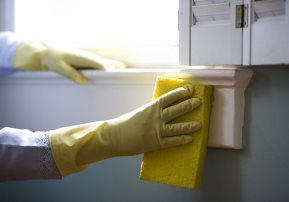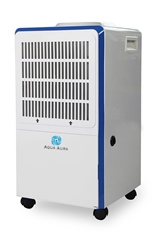
The chance of mould growing in your home increases during the winter months. This is due to extra moisture in the air and reduced ventilation in your home due to windows being shut for the cooler months.
Having mould in your home doesn’t just have a negative effect on aesthetics; it can also harm your and your family’s health. If there is mould in your home, respiratory problems can be exacerbated, and you may increase your chances of suffering from headaches or sinus congestion.
Mould or mildew can build up in your home in areas of dampness or high humidity. This can include wooden tiles, wallpaper, carpets, plants and food. Mould can grow on any of these materials and, within a few hours, can begin to release spores into the air. These can break down or damage the surfaces they land on if they are not treated.
Ways to Remove Mould in Your Home
Open a window when showering
Open the window or turn on your extractor fan if you have a bath or shower. Steam from your shower leaves moisture in the room, and if the room is not properly ventilated, mould will begin to form. If you do not have a window in your bathroom, leave the bathroom door open and ensure there is fresh air flowing in from a different room.
You should also wipe down any wet surfaces in the bathroom, including the walls and sides of the shower. The sooner you do this, the better, as if you leave it too late, water will drain off the walls onto the floor, making it slippy and harder to clean.
Don’t dry your clothes inside
Avoid hanging your clothes up to dry inside your home. If you do not have a tumble dryer, hang your clothes outside instead. By drying clothes inside, the moisture has nowhere to escape and will lead to the build-up of mould in your home.
If you live in an apartment and do not have access to an outdoor clothesline or a dryer, ensure that you dry your clothes in a well-ventilated room with a fresh supply of air running through the room.
Use your extractor fan
If you’re cooking food, ensure the extractor fan is turned on. The extractor fan is not just for removing smoke. It also removes steam too. This reduces the build-up of moisture in your kitchen while cooking.
Use a dehumidifier

If you notice a damp smell in your home or that moisture is building up, use a dehumidifier. Dehumidifiers remove moisture from the air and help control your home’s humidity levels. The prices of dehumidifiers have decreased in recent years. You can also rent dehumidifiers from some hardware stores.
Add insulation
Walls, pipes and water tanks are prone to condensation in a cold environment. This added moisture can form mould, especially as pipes or water tanks can often be in hard-to-reach areas for cleaning. Adding proper insulation reduces the chances of condensation forming.
In summary, the best way to reduce the chances of mould forming in your home is to control moisture levels with proper ventilation. The sooner you remove moisture from surfaces, the better, and always allow a fresh flow of air to circulate around your home.
Summary
| Problem | Solution | Details |
|---|---|---|
| Increased Mould Risk in Winter | Ventilation | Extra moisture and reduced ventilation in cooler months heighten mould risk. |
| Health Impact | Remove Mould | Mould can exacerbate respiratory issues and cause headaches or sinus congestion. |
| Common Mould Locations | Regular Cleaning | Areas of dampness or high humidity, like wooden tiles, wallpaper, and carpets. |
| Showering | Open Windows/Use Extractor Fans | Prevent moisture build-up in bathrooms by ventilating during and after showers. |
| Drying Clothes Inside | Outdoor Drying | Avoid indoor drying to reduce moisture; use outdoor lines or well-ventilated rooms. |
| Cooking | Extractor Fans | Use extractor fans to remove steam and reduce kitchen moisture. |
| Damp Smell/Moisture Build-up | Dehumidifiers | Control humidity levels with dehumidifiers to prevent mould growth. |
| Condensation on Walls/Pipes | Insulation | Proper insulation can prevent condensation and subsequent mould on surfaces. |
| Overall Mould Prevention | Moisture Control | Control moisture levels with proper ventilation and allow fresh air to circulate. |
If you’re a homeowner, call KennCo today for a Home Insurance quote.

